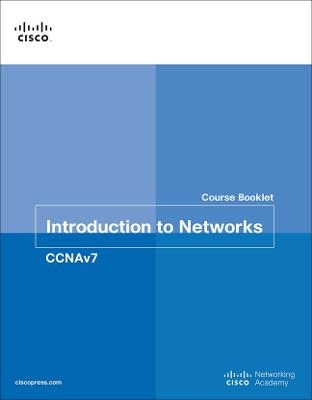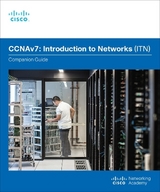
Introduction to Networks v6 Course Booklet
Cisco Press (Verlag)
978-1-58713-359-6 (ISBN)
- Titel erscheint in neuer Auflage
- Artikel merken
Your Cisco Networking Academy® Course Booklet is designed as a study resource you can easily read, highlight, and review on the go, wherever the Internet is not available or practical:
· The text is extracted directly, word-for-word, from the online course so you can highlight important points and take notes in the “Your Chapter Notes” section.
· Headings with the exact page correlations provide a quick reference to the online course for your classroom discussions and exam preparation.
· An icon system directs you to the online curriculum to take full advantage of the images embedded within the Networking Academy online course interface and reminds you to do the labs, interactive activities, packet tracer activities, watch videos, and take the chapter quizzes.
The Course Booklet is a basic, economical paper-based resource to help you succeed with the Cisco Networking Academy online course.
Related titles:
Introduction to Networks v6 Labs & Study Guide
Book: 978-1-58713-361-9
Introduction to Networks v6 Companion Guide
Book: 978-1-58713-360-2
eBook: 978-0-13-465563-5
CCNA Routing and Switching Portable Command Guide, Fourth Edition
Book: 978-1-58720-588-0
eBook: 978-0-13-446617-0
Cisco Networking Academy teaches hundreds of thousands of students annually the skills needed to build, design, and maintain networks, improving their career prospects while filling the global demand for networking professionals. With 10,000 academies in 165 countries, it helps individuals prepare for industry-recognized certifications and entry-level information and communication technology careers in virtually every industry—developing foundational technical skills while acquiring vital 21st-century career skills in problem solving, collaboration, and critical thinking. Cisco Networking Academy uses a public-private partnership model to create the "world's largest classroom."
Chapter 0 Course Introduction 1
0.0 Welcome to Introduction to Networks 1
0.0.1 Message to the Student 1
0.0.1.1 Welcome 1
0.0.1.2 A Global Community 1
0.0.1.3 More Than Just Information 1
0.0.1.4 How We Teach 2
0.0.1.5 Practice Leads to Mastery 2
0.0.1.6 Mind Wide Open 2
0.0.1.7 Engineering Journals 2
0.0.1.8 Explore the World of Networking 2
0.0.1.9 Create Your Own Worlds 3
0.0.1.10 How Packet Tracer Helps Master Concepts 3
0.0.1.11 Course Overview 3
Chapter 1 Explore the Network 5
1.0 Introduction 5
1.0.1.1 Exploring the Network 5
1.0.1.2 Class Activity - Draw Your Concept of the Internet 5
1.1 Globally Connected 6
1.1.1 Networking Today 6
1.1.1.1 Networks in Our Daily Lives 6
1.1.1.2 Technology Then and Now 6
1.1.1.3 No Boundaries 6
1.1.1.4 Networks Support the Way We Learn 7
1.1.1.5 Networks Support the Way We Communicate 7
1.1.1.6 Networks Support the Way We Work 8
1.1.1.7 Networks Support the Way We Play 8
1.1.1.8 Lab - Researching Network Collaboration Tools 8
1.1.2 Providing Resources in a Network 9
1.1.2.1 Networks of Many Sizes 9
1.1.2.2 Clients and Servers 9
1.1.2.3 Peer-to-Peer 9
1.2 LANs, WANs, and the Internet 10
1.2.1 Network Components 10
1.2.1.1 Overview of Network Components 10
1.2.1.2 End Devices 10
1.2.1.3 Intermediary Network Devices 10
1.2.1.4 Network Media 11
1.2.1.5 Network Representations 11
1.2.1.6 Topology Diagrams 11
1.2.1.7 Activity - Network Component Representations and Functions 12
1.2.2 LANs and WANs 12
1.2.2.1 Types of Networks 12
1.2.2.2 Local Area Networks 12
1.2.2.3 Wide Area Networks 13
1.2.3 The Internet, Intranets, and Extranets 13
1.2.3.1 The Internet 13
1.2.3.2 Intranets and Extranets 13
1.2.4 Internet Connections 14
1.2.4.1 Internet Access Technologies 14
1.2.4.2 Home and Small Office Internet Connections 14
1.2.4.3 Businesses Internet Connections 15
1.2.4.4 Packet Tracer - Help and Navigation Tips 15
1.2.4.5 Packet Tracer - Network Representation 15
1.3 The Network as a Platform 16
1.3.1 Converged Networks 16
1.3.1.1 Traditional Separate Networks 16
1.3.1.2 The Converging Network 16
1.3.1.3 Lab — Researching Converged Network Services 16
1.3.2 Reliable Network 16
1.3.2.1 Network Architecture 16
1.3.2.2 Fault Tolerance 17
1.3.2.3 Scalability 17
1.3.2.4 Quality of Service 17
1.3.2.5 Security 18
1.3.2.6 Activity - Reliable Networks 18
1.4 The Changing Network Environment 18
1.4.1 Network Trends 18
1.4.1.1 New Trends 18
1.4.1.2 Bring Your Own Device 19
1.4.1.3 Online Collaboration 19
1.4.1.4 Video Communication 19
1.4.1.5 Cloud Computing 20
1.4.2 Networking Technologies for the Home 20
1.4.2.1 Technology Trends in the Home 20
1.4.2.2 Powerline Networking 20
1.4.2.3 Wireless Broadband 21
1.4.3 Network Security 21
1.4.3.1 Security Threats 21
1.4.3.2 Security Solutions 22
1.4.3.3 Activity - Network Security Terminology 23
1.4.4 Network Architecture 23
1.4.4.1 Cisco Network Architecture 23
1.4.4.2 CCNA 24
1.4.4.3 Lab - Researching IT and Networking Job Opportunities 24
1.5 Summary 24
1.5.1 Conclusion 24
1.5.1.1 Class Activity — Draw Your Concept of the Internet Now 24
1.5.1.2 Warriors of the Net 25
1.5.1.3 Exploring the Network 25
Chapter 2 Configure a Network Operating System 27
2.0 Introduction 27
2.0.1.1 Configure a Network Operating System 27
2.0.1.2 Class Activity - It Is Just an Operating System 27
2.1 IOS Bootcamp 28
2.1.1 Cisco IOS 28
2.1.1.1 Operating Systems 28
2.1.1.2 Purpose of OS 28
2.1.2 Cisco IOS Access 29
2.1.2.1 Access Methods 29
2.1.2.2 Terminal Emulation Programs 29
2.1.2.3 Activity - Accessing Devices 30
2.1.3 Navigate the IOS 30
2.1.3.1 Cisco IOS Modes of Operation 30
2.1.3.2 Primary Command Modes 30
2.1.3.3 Configuration Command Modes 30
2.1.3.4 Navigate Between IOS Modes 31
2.1.4 The Command Structure 32
2.1.4.1 Basic IOS Command Structure 32
2.1.4.2 IOS Command Syntax 32
2.1.4.3 IOS Help Features 32
2.1.4.4 Hotkeys and Shortcuts 33
2.1.4.5 Video Demonstration — Hotkeys and Shortcuts 33
2.1.4.6 Packet Tracer - Navigating the IOS 33
2.1.4.7 Lab - Establishing a Console Session with Tera Term 33
2.2 Basic Device Configuration 34
2.2.1 Hostnames 34
2.2.1.1 Device Names 34
2.2.1.2 Configure Hostnames 34
2.2.2 Limit Access to Device Configurations 35
2.2.2.1 Secure Device Access 35
2.2.2.2 Configure Passwords 35
2.2.2.3 Encrypt Passwords 35
2.2.2.4 Banner Messages 36
2.2.2.5 Syntax Checker - Limiting Access to a Switch 36
2.2.3 Save Configurations 36
2.2.3.1 Save the Running Configuration File 36
2.2.3.2 Alter the Running Configuration 37
2.2.3.3 Capture Configuration to a Text File 37
2.2.3.4 Packet Tracer - Configuring Initial Switch Settings 38
2.3 Address Schemes 38
2.3.1 Ports and Addresses 38
2.3.1.1 IP Addresses 38
2.3.1.2 Interfaces and Ports 39
2.3.2 Configure IP Addressing 39
2.3.2.1 Manual IP Address Configuration for End Devices 39
2.3.2.2 Automatic IP Address Configuration for End Devices 40
2.3.2.3 Switch Virtual Interface Configuration 40
2.3.2.4 Syntax Checker - Configuring a Switch Virtual Interface 40
2.3.2.5 Packet Tracer - Implementing Basic Connectivity 41
2.3.3 Verifying Connectivity 41
2.3.3.1 Interface Addressing Verification 41
2.3.3.2 End-to-End Connectivity Test 41
2.3.3.3 Lab - Building a Simple Network 41
2.3.3.4 Lab - Configuring a Switch Management Address 41
2.4 Summary 42
2.4.1 Conclusion 42
2.4.1.1 Class Activity - Tutor Me 42
2.4.1.2 Packet Tracer - Skills Integration Challenge 42
2.4.1.3 Configure a Network Operating System 42
Chapter 3 Network Protocols and Communications 45
3.0 Introduction 45
3.0.1.1 Network Protocols and Communications 45
3.0.1.2 Class Activity - Designing a Communications System 45
3.1 Rules of Communication 46
3.1.1 The Rules 46
3.1.1.1 Communication Fundamentals 46
3.1.1.2 Rule Establishment 46
3.1.1.3 Message Encoding 47
3.1.1.4 Message Formatting and Encapsulation 47
3.1.1.5 Message Size 48
3.1.1.6 Message Timing 48
3.1.1.7 Message Delivery Options 49
3.2 Network Protocols and Standards 49
3.2.1 Protocols 49
3.2.1.1 Rules that Govern Communications 49
3.2.1.2 Network Protocols 50
3.2.1.3 Protocol Interaction 50
3.2.2 Protocol Suites 51
3.2.2.1 Protocol Suites and Industry Standards 51
3.2.2.2 Development of TCP/IP 51
3.2.2.3 TCP/IP Protocol Suite 51
3.2.2.4 TCP/IP Communication Process 52
3.2.2.5 Activity - Mapping the Protocols of the TCP/IP Suite 52
3.2.3 Standard Organizations 52
3.2.3.1 Open Standards 52
3.2.3.2 Internet Standards 53
3.2.3.3 Electronics and Communications Standard Organizations 53
3.2.3.4 Lab - Researching Networking Standards 54
3.2.4 Reference Models 54
3.2.4.1 The Benefits of Using a Layered Model 54
3.2.4.2 The OSI Reference Model 55
3.2.4.3 The TCP/IP Protocol Model 55
3.2.4.4 OSI Model and TCP/IP Model Comparison 55
3.2.4.5 Activity - Identify Layers and Functions 56
3.2.4.6 Packet Tracer - Investigating the TCP/IP and OSI Models in Action 56
3.3 Data Transfer in the Network 56
3.3.1 Data Encapsulation 56
3.3.1.1 Message Segmentation 56
3.3.1.2 Protocol Data Units 57
3.3.1.3 Encapsulation Example 57
3.3.1.4 De-encapsulation 57
3.3.1.5 Activity - Identify the PDU Layer 57
3.3.2 Data Access 57
3.3.2.1 Network Addresses 57
3.3.2.2 Data Link Addresses 58
3.3.2.3 Devices on the Same Network 58
3.3.2.4 Devices on a Remote Network 59
3.4 Summary 60
3.4.1 Conclusion 60
3.4.1.1 Lab - Installing Wireshark 60
3.4.1.2 Lab - Using Wireshark to View Network Traffic 60
3.4.1.3 Class Activity - Guaranteed to Work! 61
3.4.1.4 Network Protocols and Communications 61
Chapter 4 Network Access 63
4.0 Introduction 63
4.0.1.1 Network Access 63
4.0.1.2 Class Activity — Managing the Medium 63
4.1 Physical Layer Protocols 63
4.1.1 Physical Layer Connection 63
4.1.1.1 Types of Connections 63
4.1.1.2 Network Interface Cards 64
4.1.2 Purpose of the Physical Layer 65
4.1.2.1 The Physical Layer 65
4.1.2.2 Physical Layer Media 65
4.1.2.3 Physical Layer Standards 65
4.1.2.4 Lab - Identifying Network Devices and Cabling 66
4.1.3 Physical Layer Characteristics 66
4.1.3.1 Functions 66
4.1.3.2 Bandwidth 67
4.1.3.3 Throughput 68
4.1.3.4 Types of Physical Media 68
4.1.3.5 Activity - Physical Layer Terminology 68
4.2 Network Media 69
4.2.1 Copper Cabling 69
4.2.1.1 Characteristics of Copper Cabling 69
4.2.1.2 Copper Media 69
4.2.1.3 Unshielded Twisted-Pair Cable 70
4.2.1.4 Shielded Twisted-Pair Cable 70
4.2.1.5 Coaxial Cable 70
4.2.1.6 Copper Media Safety 71
4.2.1.7 Activity - Copper Media Characteristics 71
4.2.2 UTP Cabling 71
4.2.2.1 Properties of UTP Cabling 71
4.2.2.2 UTP Cabling Standards 72
4.2.2.3 UTP Connectors 72
4.2.2.4 Types of UTP Cable 73
4.2.2.5 Testing UTP Cables 73
4.2.2.6 Cable Pinouts 74
4.2.2.7 Lab - Building an Ethernet Crossover Cable 74
4.2.3 Fiber-Optic Cabling 74
4.2.3.1 Properties of Fiber-Optic Cabling 74
4.2.3.2 Fiber Media Cable Design 74
4.2.3.3 Types of Fiber Media 75
4.2.3.4 Fiber-Optic Connectors 75
4.2.3.5 Testing Fiber Cables 76
4.2.3.6 Fiber versus Copper 76
4.2.3.7 Activity - Fiber Optics Terminology 76
4.2.4 Wireless Media 76
4.2.4.1 Properties of Wireless Media 76
4.2.4.2 Types of Wireless Media 77
4.2.4.3 Wireless LAN 78
4.2.4.4 Packet Tracer — Connecting a Wired and Wireless LAN 78
4.2.4.5 Lab - Viewing Wired and Wireless NIC Information 78
4.3 Data Link Layer Protocols 78
4.3.1 Purpose of the Data Link Layer 78
4.3.1.1 The Data Link Layer 78
4.3.1.2 Data Link Sublayers 79
4.3.1.3 Media Access Control 79
4.3.1.4 Providing Access to Media 80
4.3.1.5 Data Link Layer Standards 80
4.4 Media Access Control 81
4.4.1 Topologies 81
4.4.1.1 Controlling Access to the Media 81
4.4.1.2 Physical and Logical Topologies 81
4.4.2 WAN Topologies 82
4.4.2.1 Common Physical WAN Topologies 82
4.4.2.2 Physical Point-to-Point Topology 82
4.4.2.3 Logical Point-to-Point Topology 82
4.4.3 LAN Topologies 83
4.4.3.1 Physical LAN Topologies 83
4.4.3.2 Half and Full Duplex 83
4.4.3.3 Media Access Control Methods 84
4.4.3.4 Contention-Based Access — CSMA/CD 84
4.4.3.5 Contention-Based Access — CSMA/CA 85
4.4.4 Data Link Frame 85
4.4.4.1 The Frame 85
4.4.4.2 Frame Fields 85
4.4.4.3 Activity — Generic Frame Fields 86
4.4.4.4 Layer 2 Address 86
4.4.4.5 LAN and WAN Frames 87
4.5 Summary 88
4.5.1 Conclusion 88
4.5.1.1 Class Activity — Linked In! 88
4.5.1.2 Network Access 88
Chapter 5 Ethernet 91
5.0 Introduction 91
5.0.1.1 Ethernet 91
5.0.1.2 Class Activity - Join My Social Circle! 91
5.1 Ethernet Protocol 92
5.1.1 Ethernet Frame 92
5.1.1.1 Ethernet Encapsulation 92
5.1.1.2 MAC Sublayer 93
5.1.1.3 Ethernet Evolution 93
5.1.1.4 Ethernet Frame Fields 94
5.1.1.5 Activity - MAC and LLC Sublayers 94
5.1.1.6 Activity - Ethernet Frame Fields 94
5.1.1.7 Lab - Using Wireshark to Examine Ethernet Frames 94
5.1.2 Ethernet MAC Addresses 94
5.1.2.1 MAC Address and Hexadecimal 94
5.1.2.2 MAC Address: Ethernet Identity 95
5.1.2.3 Frame Processing 95
5.1.2.4 MAC Address Representations 96
5.1.2.5 Unicast MAC Address 96
5.1.2.6 Broadcast MAC Address 97
5.1.2.7 Multicast MAC Address 97
5.1.2.8 Lab - Viewing Network Device MAC Addresses 97
5.2 LAN Switches 98
5.2.1 The MAC Address Table 98
5.2.1.1 Switch Fundamentals 98
5.2.1.2 Learning MAC Addresses 98
5.2.1.3 Filtering Frames 99
5.2.1.4 Video Demonstration - MAC Address Tables on Connected Switches 99
5.2.1.5 Video Demonstration - Sending a Frame to the Default Gateway 99
5.2.1.6 Activity - Switch It! 100
5.2.1.7 Lab - Viewing the Switch MAC Address Table 100
5.2.2 Switch Forwarding Methods 100
5.2.2.1 Frame Forwarding Methods on Cisco Switches 100
5.2.2.2 Cut-Through Switching 101
5.2.2.3 Memory Buffering on Switches 101
5.2.2.4 Activity - Frame Forwarding Methods 102
5.2.3 Switch Port Settings 102
5.2.3.1 Duplex and Speed Settings 102
5.2.3.2 Auto-MDIX 103
5.3 Address Resolution Protocol 103
5.3.1 MAC and IP 103
5.3.1.1 Destination on Same Network 103
5.3.1.2 Destination Remote Network 104
5.3.1.3 Packet Tracer — Identify MAC and IP Addresses 105
5.3.2 ARP 105
5.3.2.1 Introduction to ARP 105
5.3.2.2 ARP Functions 105
5.3.2.3 Video Demonstration — ARP Request 106
5.3.2.4 Video Demonstration — AR
| Erscheinungsdatum | 17.02.2017 |
|---|---|
| Reihe/Serie | Course Booklets |
| Verlagsort | Indianapolis |
| Sprache | englisch |
| Maße | 216 x 274 mm |
| Gewicht | 630 g |
| Themenwelt | Mathematik / Informatik ► Informatik ► Netzwerke |
| Informatik ► Office Programme ► Office | |
| ISBN-10 | 1-58713-359-8 / 1587133598 |
| ISBN-13 | 978-1-58713-359-6 / 9781587133596 |
| Zustand | Neuware |
| Haben Sie eine Frage zum Produkt? |
aus dem Bereich



